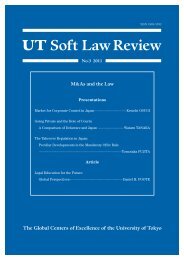UT Soft Law Review
UT Soft Law Review
UT Soft Law Review
You also want an ePaper? Increase the reach of your titles
YUMPU automatically turns print PDFs into web optimized ePapers that Google loves.
<strong>UT</strong> <strong>Soft</strong> <strong>Law</strong> <strong>Review</strong> No.2 2010calculated on the basis of data including Company Y’s business plan, matters pertaining to theeffect of a takeover acquisition on Company Y’s minority shareholders, and matters pertainingto the content of an acquisition proposal from a buyer), the board of directors was to adopt aresolution to either cancel the share options without charge or to not cancel them withoutcharge, depending on which of those resolutions would maximize Company Y’s corporatevalue; (10) When voting on this resolution, the board of directors was to set the utmost valueon the recommendations of a special committee; and (11) The special committee was to becomprised of three members in total, two of whom would be attorneys, certified publicaccountants or persons with relevant knowledge and experience having no interest in thecancellation or non-cancellation of the share options in this case, who would be designated byCompany Y’s Representative Director & President and Company Y’s board of directors.(Although while this case was pending these guidelines were amended by Company Y’s boardof directors at a meeting on 20 May, the details of those amendments can be omitted here.)In order to be recorded as a shareholder in Company Y’s shareholder registry on 31 March2005 (the allotment record date (vesting date) for the share options), investors were requiredto purchase shares in the company at least four business days prior to the record date. Thismeant that, in this case, if investors did not buy Company Y shares by Friday 25 March, theycould not receive an allotment of the share options.On grounds including that the share option issue in this case constituted an unfair issue, Xfiled suit for a provisional injunction. (The Tokyo District Court did not accept X’s othergrounds, which were therefore not taken up by the Tokyo High Court in its ruling. Accordinglythey are omitted from this report.) The originating court ruled in favor of the provisionalinjunction against the share options in this case. In response to Company Y’s petition objectingto the provisional injunction, the originating court confirmed the initial ruling to allow theprovisional injunction. Company Y therefore brought an appeal to the court of last resortunder the <strong>Law</strong> of Civil Provisional Remedies, seeking to set aside the originating court’sdecision.[Summary of Decision](1) On the purpose behind the Plan: “It may be accepted by and large that the Plan has –as Company Y asserts – a preventive function, in that the share options scheme in this casewill be employed to put a temporary halt early on to any takeover by a buyer, thereby givingthat buyer a motive to negotiate in earnest with the board of directors over the terms of thetakeover, in effect ensuring that the buyer will create an opportunity for negotiations.However, the consequence of reducing the shareholding ratio of a particular shareholderthrough the exercise of the share options, in order to defend the company from a predatorybuyer, will be to maintain or secure control of the company by the managers at that time or byparticular shareholders who support that management. In that context, given both the116





